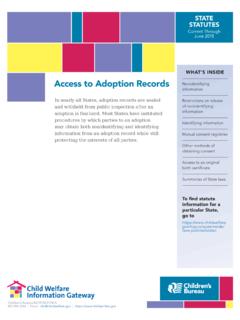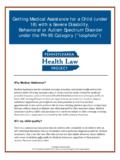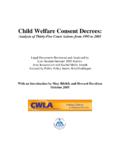Transcription of Child Abuse and Neglect Fatalities 2010: Statistics and ...
1 Child welfare Information GatewayChildren s Bureau/ACYF1250 Maryland Avenue, SWEighth FloorWashington, DC : AND TRENDSMay 2012 Use your smartphone to access these numbers and trends Abuse and Neglect Fatalities 2010 : Statistics and Interventions Despite the efforts of the Child protection system, Child maltreatment Fatalities remain a serious Although the untimely deaths of children due to illness and accidents have been closely monitored, deaths that result from physical assault or severe Neglect can be more difficult to track. The circumstances surrounding a Child s death, its investigation, and communication across all the disciplines involved complicate data collection. 1 This factsheet provides information regarding Child deaths resulting from Abuse or Neglect by a parent or a primary caregiver.
2 Other Child homicides, such as those committed by acquaintances and strangers, and other causes of death, such as unintentional injuries, are not discussed here. For information about leading causes of Child death nationally from 1999 to 2007, visit the Centers for Disease Control and Prevention website at Statistics regarding Child homicide from 1976 to 2005 can be obtained from the Department of Justice: Abuse and Neglect Fatalities 2010 : Statistics and material may be freely reproduced and distributed. However, when doing so, please credit Child welfare Information Gateway. Available online at otherwise noted, Statistics in this factsheet are taken from Child Maltreatment 2010 and refer to the Federal fiscal year (FFY) 2010 ( Department of Health and Human Services, 2011).
3 According to data from the National Child Abuse and Neglect Data System (NCANDS), 51 States reported a total of 1,537 Fatalities . Based on these data, a nationally estimated 1,560 children died from Abuse and Neglect in 2010 . This translates to a rate of children per 100,000 children in the general population and an average of four children dying every day from Abuse or Neglect . NCANDS defines Child fatality as the death of a Child caused by an injury resulting from Abuse or Neglect or where Abuse or Neglect was a contributing factor. The number and rate of Fatalities have fluctuated during the past 5 years. The national estimate is influenced by which States report data. For 2010 , several States that reported fewer Fatalities compared to previous years provided explanations in their commentaries that included system improvements that reduced case backlogs and the introduction of successful prevention data on Child Fatalities come from State Child welfare agencies.
4 However, States may also draw on other data sources, including health departments, vital Statistics departments, medical examiners offices, and fatality review teams. This coordination of data collection contributes to better estimates. Many researchers and practitioners believe that Child Fatalities due to Abuse and Neglect are still underreported. Studies in Nevada and Colorado have estimated that as many as 50 percent to 60 percent of Child deaths resulting from Abuse or Neglect are not recorded as such ( Child Fatality Analysis [Clark County], 2005; Crume, DiGuiseppi, Byers, Sirotnak, & Garrett, 2002).Issues affecting the accuracy and consistency of Child fatality data include: How many children die each year from Child Abuse or Neglect ?
5 Child Abuse and Neglect Fatalities 2010 : Statistics and material may be freely reproduced and distributed. However, when doing so, please credit Child welfare Information Gateway. Available online at a Variation among reporting requirements and definitions of Child Abuse and Neglect and other terms Variation in death investigation systems and training Variation in State Child fatality review and reporting processes The length of time (up to a year in some cases) it may take to establish Abuse or Neglect as the cause of death Inaccurate determination of the manner and cause of death, resulting in the miscoding of death certificates; this includes deaths labeled as accidents, sudden infant death syndrome (SIDS), or manner undetermined that would have been attributed to Abuse or Neglect if more comprehensive investigations had been conducted (Hargrove & Bowman, 2007)
6 Limited coding options for Child deaths, especially those due to Neglect or negligence, when using the International Classification of Diseases to code death certificates The ease with which the circumstances surrounding many Child maltreatment deaths can be concealed or rendered unclear Lack of coordination or cooperation among different agencies and jurisdictionsA number of studies, including some funded by the Centers for Disease Control and Prevention, have suggested that more accurate counts of maltreatment deaths are obtained by linking multiple reporting sources, including death certificates, crime reports, Child protective services (CPS) reports, and Child death review (CDR) records (Mercy, Barker, & Frazier, 2006).
7 A study of Child Fatalities in three States found that combining at least two data sources resulted in the identification of more than 90 percent of Child Fatalities ascertained as due to Child maltreatment (Schnitzer, Covington, Wirtz, Verhoek-Oftedahl, & Palusci, 2008). Child Abuse and Neglect Fatalities 2010 : Statistics and material may be freely reproduced and distributed. However, when doing so, please credit Child welfare Information Gateway. Available online at What groups of children are most vulnerable?Research indicates that very young children (ages 4 and younger) are the most frequent victims of Child Fatalities . NCANDS data for 2010 demonstrated that children younger than 1 year accounted for percent of Fatalities ; children younger than 4 years accounted for nearly four-fifths ( percent) of Fatalities .
8 These children are the most vulnerable for many reasons, including their dependency, small size, and inability to defend themselves. How do these deaths occur?Fatal Child Abuse may involve repeated Abuse over a period of time ( , battered Child syndrome), or it may involve a single, impulsive incident ( , drowning, suffocating, or shaking a baby). In cases of fatal Neglect , the Child s death results not from anything the caregiver does, but from a caregiver s failure to act. The Neglect may be chronic ( , extended malnourishment) or acute ( , an infant who drowns after being left unsupervised in the bathtub).In 2010 , more than two-fifths of Fatalities ( percent) were caused by multiple forms of maltreatment.
9 Neglect alone accounted for percent, and physical Abuse alone accounted for percent. Medical Neglect accounted for percent of Abuse and Neglect Fatalities 2010 : Statistics and material may be freely reproduced and distributed. However, when doing so, please credit Child welfare Information Gateway. Available online at a Who are the perpetrators?No matter how the fatal Abuse occurs, one fact of great concern is that the perpetrators are, by definition, individuals responsible for the care and supervision of their victims. In 2010 , parents, acting alone or with another person, were responsible for percent of Child Abuse or Neglect Fatalities . Almost 30 percent ( percent) were perpetrated by the mother acting alone.
10 Child Fatalities with unknown perpetrator relationship data accounted for percent of the is no single profile of a perpetrator of fatal Child Abuse , although certain characteristics reappear in many studies. Frequently, the perpetrator is a young adult in his or her mid-20s, without a high school diploma, living at or below the poverty level, depressed, and who may have difficulty coping with stressful situations. Fathers and mothers boyfriends are most often the perpetrators in Abuse deaths; mothers are more often at fault in Neglect National Center for Child Death Review: How do communities respond to Child Fatalities ?The response to the problem of Child Abuse and Neglect Fatalities is often hampered by inconsistencies, including: Underreporting of the number of children who die each year as a result of Abuse and Neglect Lack of consistent standards for Child autopsies or death investigations Child Abuse and Neglect Fatalities 2010 : Statistics and material may be freely reproduced and distributed.




